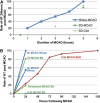Hemorrhagic transformation after ischemic stroke in animals and humans
- PMID: 24281743
- PMCID: PMC3915212
- DOI: 10.1038/jcbfm.2013.203
Hemorrhagic transformation after ischemic stroke in animals and humans
Abstract
Hemorrhagic transformation (HT) is a common complication of ischemic stroke that is exacerbated by thrombolytic therapy. Methods to better prevent, predict, and treat HT are needed. In this review, we summarize studies of HT in both animals and humans. We propose that early HT (<18 to 24 hours after stroke onset) relates to leukocyte-derived matrix metalloproteinase-9 (MMP-9) and brain-derived MMP-2 that damage the neurovascular unit and promote blood-brain barrier (BBB) disruption. This contrasts to delayed HT (>18 to 24 hours after stroke) that relates to ischemia activation of brain proteases (MMP-2, MMP-3, MMP-9, and endogenous tissue plasminogen activator), neuroinflammation, and factors that promote vascular remodeling (vascular endothelial growth factor and high-moblity-group-box-1). Processes that mediate BBB repair and reduce HT risk are discussed, including transforming growth factor beta signaling in monocytes, Src kinase signaling, MMP inhibitors, and inhibitors of reactive oxygen species. Finally, clinical features associated with HT in patients with stroke are reviewed, including approaches to predict HT by clinical factors, brain imaging, and blood biomarkers. Though remarkable advances in our understanding of HT have been made, additional efforts are needed to translate these discoveries to the clinic and reduce the impact of HT on patients with ischemic stroke.
Figures





References
-
- Terruso V, D'Amelio M, Di Benedetto N, Lupo I, Saia V, Famoso G, et al. Frequency and determinants for hemorrhagic transformation of cerebral infarction. Neuroepidemiology. 2009;33:261–265. - PubMed
-
- Fiorelli M, Bastianello S, von Kummer R, del Zoppo GJ, Larrue V, Lesaffre E, et al. Hemorrhagic transformation within 36 hours of a cerebral infarct: relationships with early clinical deterioration and 3-month outcome in the European Cooperative Acute Stroke Study I (ECASS I) cohort. Stroke. 1999;30:2280–2284. - PubMed
-
- Khatri P, Wechsler LR, Broderick JP. Intracranial hemorrhage associated with revascularization therapies. Stroke. 2007;38:431–440. - PubMed
-
- Berger C, Fiorelli M, Steiner T, Schabitz WR, Bozzao L, Bluhmki E, et al. Hemorrhagic transformation of ischemic brain tissue: asymptomatic or symptomatic. Stroke. 2001;32:1330–1335. - PubMed
Publication types
MeSH terms
Substances
LinkOut - more resources
Full Text Sources
Other Literature Sources
Medical
Miscellaneous

